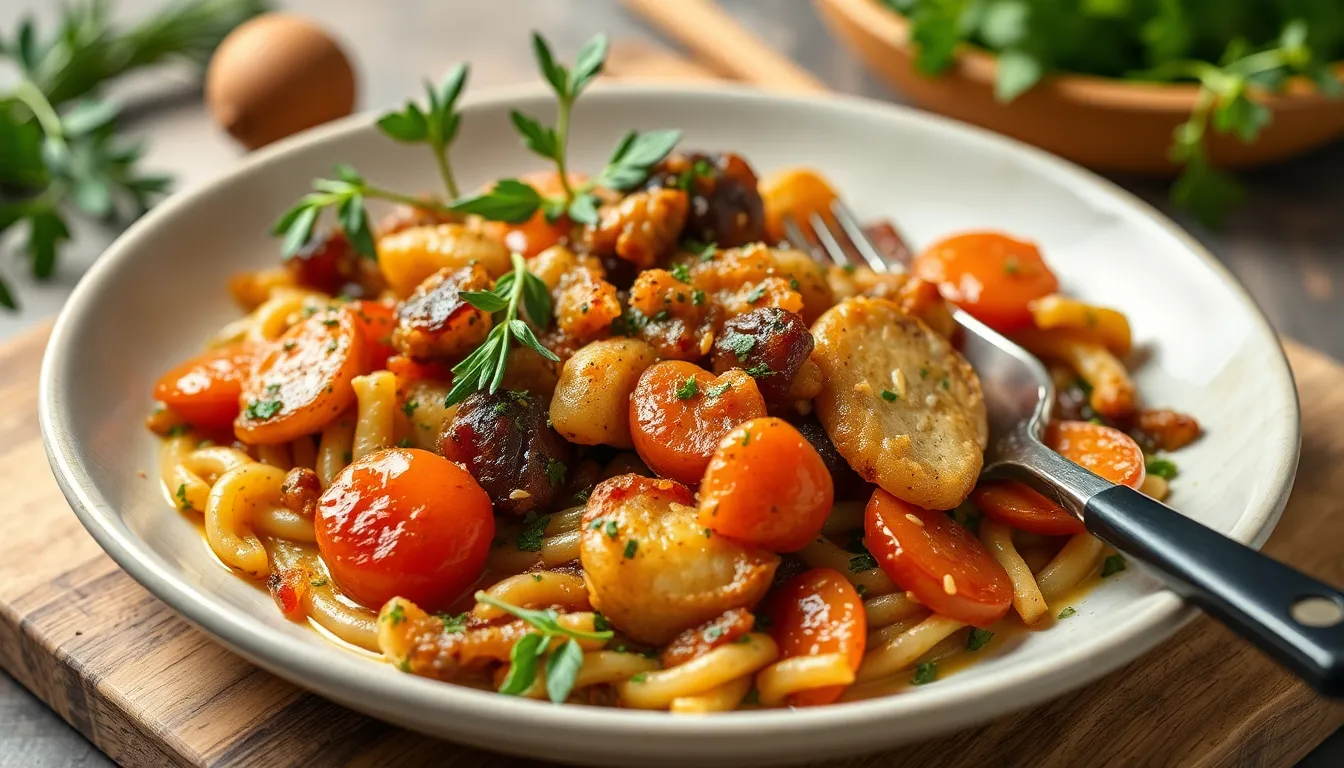table {
width: 100%;
border-collapse: collapse;
margin: 20px 0;
}
th, td {
border: 1px solid #ddd;
padding: 8px;
text-align: left;
}
th {
background-color: #f2f2f2;
}
h2, h3 {
color: #4CAF50;
}
Cooking with Herbs: Creative Ways to Use Fresh Ingredients
I. Introduction
Fresh herbs are a cornerstone of culinary arts, transforming dishes and elevating flavors in ways that dried herbs simply cannot match. They bring vibrancy, depth, and nutrition to meals, making them an essential component for both home cooks and professional chefs alike.
Using fresh herbs not only enhances flavor but also adds numerous health benefits. Many herbs are rich in vitamins, antioxidants, and anti-inflammatory compounds. Incorporating them into your diet can improve digestion, boost immunity, and even enhance mental clarity.
This article aims to inspire you to explore the creative uses of fresh herbs in everyday cooking, encouraging experimentation that will enhance your meals and your culinary repertoire.
II. Types of Fresh Herbs
A. Common culinary herbs and their flavor profiles
Understanding the distinct flavors of common culinary herbs can significantly enhance your cooking. Here are some essential fresh herbs to consider:
- Basil: Sweet, slightly peppery; perfect for Italian dishes and salads.
- Parsley: Fresh and mildly bitter; versatile for garnishing and flavoring.
- Cilantro: Bright and citrusy; commonly used in Mexican and Asian cuisines.
- Thyme: Earthy and floral; excellent in soups, stews, and roasted meats.
- Rosemary: Pine-like and aromatic; great for grilled meats and focaccia.
B. Less common herbs to experiment with
While common herbs are staples, branching out into less common varieties can open up new culinary possibilities:
- Chervil: Delicate with a hint of anise; ideal for French cuisine.
- Lemon Balm: Minty and lemony; perfect for infusing teas and desserts.
- Tarragon: Sweet and anise-flavored; pairs well with poultry and sauces.
C. Comparison of Common Herbs
| Herb | Flavor Profile | Best Pairings | Culinary Uses |
|---|---|---|---|
| Basil | Sweet, slightly peppery | Tomatoes, mozzarella | Pasta, salads, sauces |
| Parsley | Fresh, mildly bitter | Garlic, lemon | Salsas, garnishes |
| Cilantro | Bright, citrusy | Chili, lime | Salsas, curries |
| Thyme | Earthy, floral | Meats, vegetables | Soups, stews |
| Rosemary | Pine-like, aromatic | Potatoes, lamb | Grilling, baking |
III. Creative Ways to Use Fresh Herbs
A. Infusing Oils and Vinegars
Herb-infused oils and vinegars are a fantastic way to capture the essence of fresh herbs to use over time. Here’s how you can make your own:
Instructions for Making Herb-Infused Oils
- Choose your herbs: Basil, rosemary, or thyme work particularly well.
- Gently wash and dry the herbs.
- In a clean jar, combine your herbs with your choice of oil (olive oil is ideal).
- Seal the jar and place it in a warm, dark place for at least 1 week, shaking it gently every couple of days.
- Strain the oil into another clean container, discarding the herbs.
Suggestions for Herb-Infused Vinegars
Infused vinegars can add a unique flavor to salad dressings and marinades. Consider the following herbs:
- Thyme: Great for Mediterranean dishes.
- Mint: Refreshing for summer salads.
- Basil: Excellent for Italian-inspired vinaigrettes.
B. Herb Sauces and Pestos
Herb-based sauces can transform a simple dish into a gourmet experience. Here are some ideas:
Classic Pesto Recipe with Variations
Ingredients:
- 2 cups fresh basil leaves
- 1/2 cup grated Parmesan cheese
- 1/2 cup olive oil
- 1/3 cup pine nuts (or walnuts)
- 2 garlic cloves
- Salt to taste
Instructions:
1. In a food processor, combine basil, cheese, nuts, and garlic.
2. Pulse until finely chopped.
3. With the processor running, slowly add olive oil until smooth.
4. Season with salt to taste.
5. Store in the refrigerator for up to a week.
Variations include substituting different nuts, using arugula instead of basil, or adding roasted red peppers for a twist.
Other Herb-Based Sauces
- Chimichurri: A zesty sauce made with parsley, garlic, vinegar, and olive oil, perfect for grilled meats.
- Green Goddess Dressing: A creamy dressing made with fresh herbs like tarragon and chives, great on salads or as a dip.
C. Flavoring Grains and Legumes
Enhancing grains and legumes with fresh herbs can elevate these staples to a new level:
Cooking Grains with Herbs
- Add a handful of herbs (like thyme or rosemary) to the water when cooking rice or quinoa for added flavor.
- Mix finely chopped herbs into cooked grains for a fresh touch.
Herb-Infused Beans and Lentils
Consider adding herbs during the cooking process:
- Add bay leaves or thyme to lentils while they simmer for a flavor boost.
- Herbs like parsley or cilantro can be stirred in just before serving for a fresh finish.
D. Incorporating Herbs into Baked Goods
Herbs can also play a role in baking, adding interest and flavor to both savory and sweet items:
Savory Herb Breads and Focaccia
- Incorporate chopped herbs like rosemary or oregano into your bread dough.
- Top focaccia with olive oil, sea salt, and fresh herbs before baking.
Sweet Herb-Infused Desserts
Herbs like lavender and basil can add unique notes to desserts:
- Lavender Cookies: Infuse butter with dried lavender flowers before incorporating it into cookie dough.
- Basil Ice Cream: Steep fresh basil in the cream mixture before churning for a refreshing treat.
IV. Herb Pairing Tips
A. How to Pair Herbs with Different Proteins and Vegetables
Pairing herbs with the right proteins and vegetables can enhance the overall flavor profile of your dishes:
- Basil: Pairs well with chicken, tomatoes, and mozzarella.
- Thyme: Complements beef, lamb, and root vegetables.
- Cilantro: Works beautifully with fish, chicken, and avocados.
B. Seasonal Herb Pairings for Optimal Flavor
Choosing herbs based on the season can greatly enhance their flavors:
- Spring: Fresh basil, chervil, and tarragon.
- Summer: Cilantro, dill, and mint.
- Fall: Rosemary, sage, and thyme.
- Winter: Parsley, chives, and bay leaves.
C. Herb Pairing Guide
| Herb | Best Pairings | Dish Suggestions |
|---|---|---|
| Basil | Tomatoes, mozzarella, chicken | Pasta, salads, bruschetta |
| Thyme | Beef, lamb, root vegetables | Stews, roasts |
| Cilantro | Fish, chicken, avocados | Tacos, salsas |
| Rosemary | Pork, potatoes, bread | Roasted dishes, focaccia |
| Parsley | Fish, grains, salads | Tabbouleh, garnishes |
V. Storing and Preserving Fresh Herbs
A. Best Practices for Storing Fresh Herbs in the Refrigerator
To keep fresh herbs vibrant for longer, follow these storage tips:
- Wrap herbs like parsley and cilantro in a damp paper towel and place them in a plastic bag.
- Store hard herbs like rosemary and thyme upright in a jar with water, covering the tops with a plastic bag.
B. Freezing Herbs for Later Use
Freezing is a great way to preserve herbs:
- Chop herbs and mix them with olive oil in an ice cube tray.
- Freeze individual leaves in airtight bags, squeezing out as much air as possible.
C. Drying Herbs and Making Herb Blends
Drying herbs extends their shelf life significantly:
- Hang herbs in a dark, dry place until fully dried, then store them in airtight containers.
- Create your own herb blends (like Italian seasoning) by combining dried herbs in equal parts.
VI. Conclusion
Fresh herbs are incredibly versatile and can transform your cooking in numerous ways. From infusing oils to creating vibrant sauces and enhancing baked goods, the possibilities are endless. We encourage you to experiment with different herbs, discover their flavor profiles, and incorporate them into your dishes.
We invite you to share your favorite herb recipes in the comments below, and let’s inspire each other to embrace the wonderful world of fresh herbs!
VII. Call to Action
If you enjoyed this article and want more cooking tips and recipes, don’t forget to subscribe to our blog! Follow us on social media for daily inspiration and to connect with a community of passionate cooks.
VIII. Additional Resources
For those interested in herb gardening, here are some valuable resources:
https://www.youtube.com/watch?v=1LJ7TA8pQZ8




